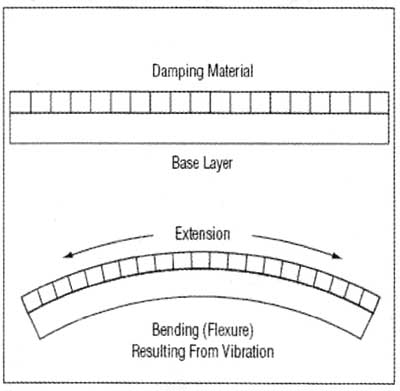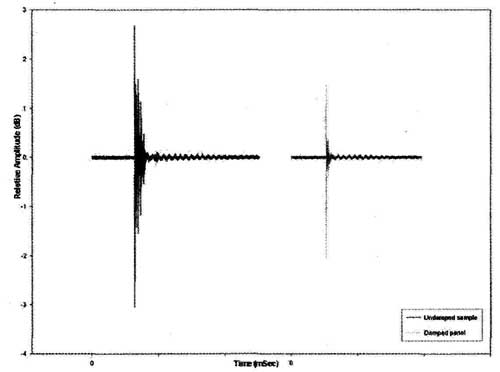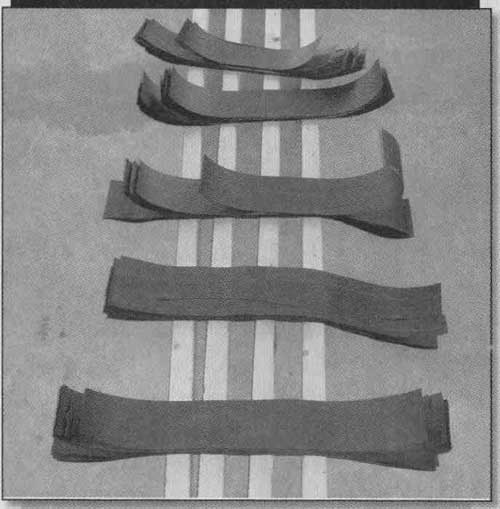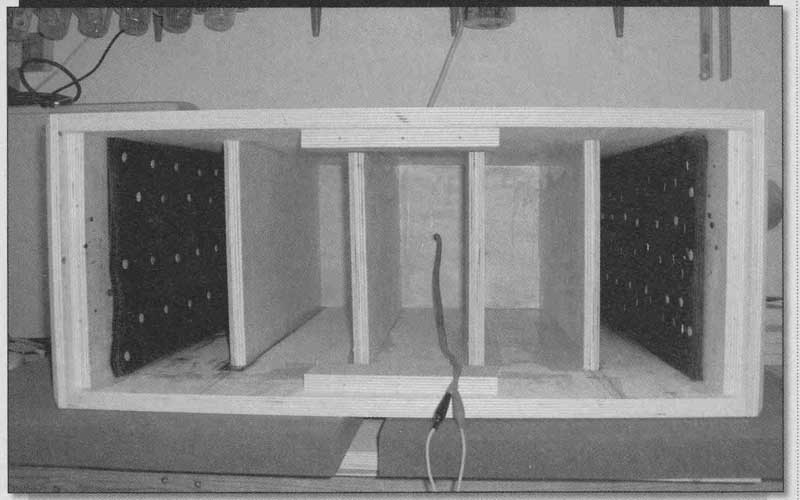|
|
Discover how reducing panel vibrations will improve the sound of your system.
Earlier, we looked at the math and theory underpinning the mechanics of panel vibration. Now, we’ll take an empirical look at panel vibration, investigating with both accelerometer and microphone. The mechanical and acoustical performance of a loudspeaker cabinet’s panel will be assessed at various stages of construction, with an eye to noting any improvements along the way. This report will conclude with a simple before/after comparison of the acoustical output of one of the test cabinet’s panels, followed by a subjective assessment of the system’s performance.
DAMPING
There are two modes of mechanical damping commonly employed in loud speaker construction: extensional and shearing.
In extensional mode (free substrate layer) a second, visco-elastic material absorbs kinetic (vibrational) energy from, in this case, a vibrating plywood panel substrate, converting it into heat (Fig. 1). The effectiveness of this approach depends upon the degree of panel flexure as well as the mechanical and physical properties of both the damping and substrate layers. Additionally, it’s useful to know the mechanical properties of the adhesive used: if the mechanical impedance of the adhesive is low enough, the damping pad will function as a constraining layer. Whether this is actually desirable or not can only be determined by further measurement.
Shearing mode (constrained layer damping), as seen in Fig. 2, is an alternate approach in which a vibrating panel is constrained by a second panel of sufficiently high mechanical impedance. In this mode, the two panels—one vibrating, the other constraining—are joined by an adhesive viscoelastic damping layer. Energy is dissipated through tensional forces of sheer deformation. Intuitively, it might appear the thicker the adhesive damping layer, the more damping. In practice, however, the opposite holds true: the thinner the layer, the more effective constrained layer damping (CUD).

FIGURE 2: Shearing mode. Base Layer (Sabstrate)
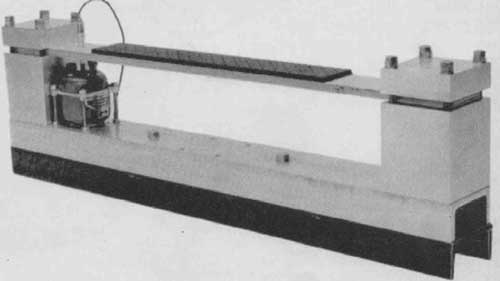
PHOTO 1: Sample test rig (courtesy BBC).
So which method is best? In my experience (and all else being equal) CLD has generally provided for a higher degree of panel damping when compared to extensional mode damping, as applied to plywood cabinets constructed for mid-bass or even LF purposes. How ever, it’s more costly and less forgiving regarding the selection of the appropriate materials. If your budget allows for it, I recommend you experiment with both approaches. If your budget is tight, stick with the less expensive, non-CLD approach, which works well, as you’ll see.
TEST RIG
In order to investigate the vibration-damping effectiveness of various materials, I built a test rig that allowed for quick, repeatable measurements of various, commonly available North American plywood panel samples along with various common, commercial damping materials. Similar in appearance to that shown in Photo 1, the rig included two solid, heavy mount points to which the rectangular-shaped panel samples were clamped at each end.
The panel samples were set in motion by the impact of a 100 gram disk-shaped weight, dropped from a height of 30cm. The test panels were angled 45° along their long axis. In doing so, the disk, when dropped on its edge, would impact, then fly off the panel, coming to rest off the panel, thus not interfering with the post-impact vibrational behavior of the individual wood samples.
Working up a series of before/after comparisons, as seen in Figs. 3 and 4, didn’t require absolute measurement values; therefore, using an uncalibrated accelerometer is a valid approach. I could have used a calibrated accelerometer but chose instead to experiment with an inexpensive accelerometer I’d seen mentioned in both online forums and print media.
The Measurement Specialties ACH 01 worked quite well, and the ±3dB 2Hz-20kHz typical amplitude response, along with a ±150g dynamic range, made it a very cost-effective, suitable choice. It’s available through retailers such as Digi-Key and makes for a worthwhile addition to any DIY audioholic’s toolkit.
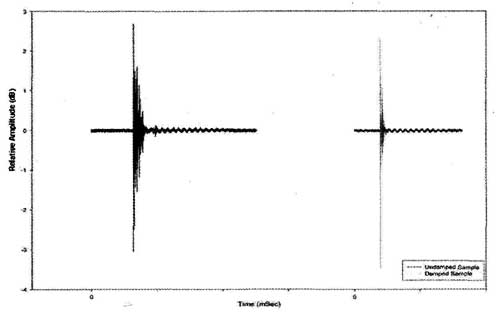
FIGURE 3: Plain board vs. damping material, lightly placed.
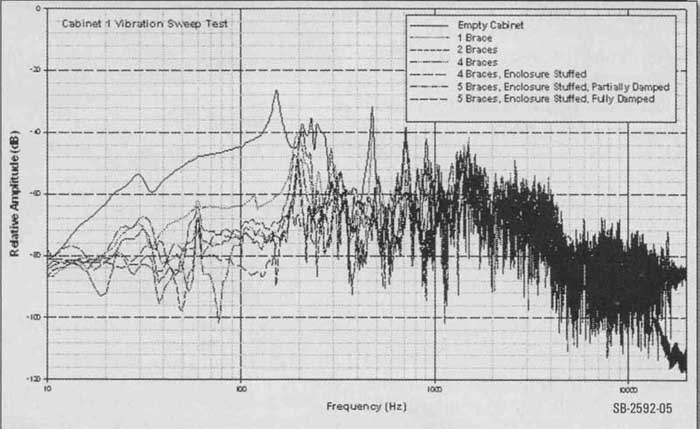
FIGURE 5: Vibrational panel responses.
The wood I chose for this project from the half-dozen test sample candidates was 19mm (.75') thick, void-free Baltic birch. I frequently use this (or its marine-grade derivative) and have found it to be a consistently top-quality engineered wood product (Photo 2).
The damping material used in this case was a multi-ply "panel" built up from heavy, self-adhering roofing material, which, sold in long rolls, you can easily cut to fit as needed (Photo 3). Multiply the amount shown by 5.5 to get an idea of the total amount used in the construction of both cabinets.
The half-dozen plywood test samples used were (free length) approximately 70cm (27.6") long and just over 12cm (4.7") wide. I chose the free length as being a reasonable approximation of a typical loud speaker cabinet's panel height. I chose the width to keep mechanical impedance low and to minimize transverse resonance modes. The results of the test series shown in Figs. 3 and 4 are taken from the Baltic birch test sample.
ACCELEROMETER RESULTS
Whether you use an inexpensive accelerometer, such as the ACH-01, or a more expensive calibrated accelerometer, a few caveats are in order. First, due to the sensitivity of accelerometers suitable for measuring loudspeaker panel vibration, it's easy for extraneous vibrational noise from nearby fans, motors, traffic, and so on, to creep into your measurements. Second, be consistent in your choice of base or support for your cabinet under test. Measure your cabinet while it rests on, for example, the concrete floor of a garage. Then re-measure it with the cabinet perched on top of a wooden workbench. This will produce different results, invalidating even comparisons based on relative amplitude measurements.
On the left-hand side of Fig. 3, you see the amplitude response generated by the accelerometer fixed to the undamped panel sample. On the right- hand side is the response of the same sample but with the damping material lightly affixed to the panel. (Both impulse responses are on the same amplitude/time scale.) Already a significant difference is evident. Clearly, the plywood panel, when damped, settles much more quickly than when undamped.
The damped response in Fig. 7 resulted when the damping material was directly adhered to the plywood test sample. In Fig. 4, you can see an improved settling time when comparing the damped amplitude response with that in Fig. 3. Clearly, adhering each layer to its neighbor, then adhering the multi-ply damping panel directly to the plywood test sample is preferable.
It’s tempting to think that when it comes to the application of a damping material, the more the better. However, there exists a point of diminishing re turns, where more is not better. From an empirical standpoint, building a damping pad of the particular material used in this project one-half to three- fourths the thickness of the plywood panel substrate is a good starting point when setting out to determine optimal thickness.
BRACING
After I assessed the effectiveness of the free-layer damping approach, it was time to build the test enclosures.
I designed the enclosure to have four solid cross braces, oriented horizontally, fixed to the interior side of the cabinet’s side and back panels, with the front edge close to, but not touching, the inside of the faceplate. An FEA simulation done prior to construction indicated four cross braces would produce acceptable results.
To gauge the effectiveness of the bracing and damping approaches, I made a series of measurements at different points in the construction process using the ACH-01 accelerometer, along with a calibrated microphone for capturing acoustic measurements, useful in subsequent analysis. The enclosure sported double-thickness (38mm) front, top, and bottom panels, with the sides and back being single thickness (19mm) panels. Photo 4 shows one of the enclosures midway through construction.
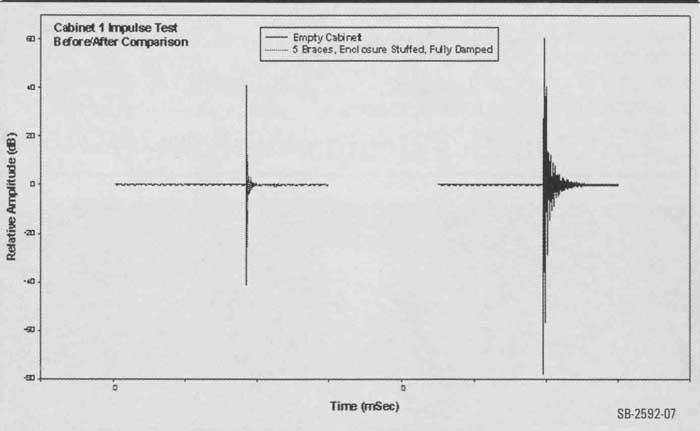
FIGURE 7: Before/after impulse comparison.
In addition to the four horizontal, shelf-style braces, the front panel was cross-braced as well, with a thin shelf style 5 brace running from the inside center point of the faceplate to the back of the enclosure. The use of extensive bracing and damping added to the al ready substantial weight of the cabinets. The completed enclosures weighed over 100kg (220 lbs) each!
In Fig. 5 you can see an heroically busy collection of plots, each sweep indicating the vibrational behavior of the panel to which the accelerometer had been affixed (the center of the left or top panel in Photo 4) at various stages of construction. You can see the net before/after result of all the bracing, damping, and stuffing in Fig. 6.
In Fig. 6, note a general downward shift in amplitude, accompanied by an upward shift in frequency whencom paring the “after” curve with the “be fore” curve. Keep in mind these are not dB SPL curves, but the relative response of an accelerometer responding to the cabinet panel’s acceleration at each frequency along the sweep.
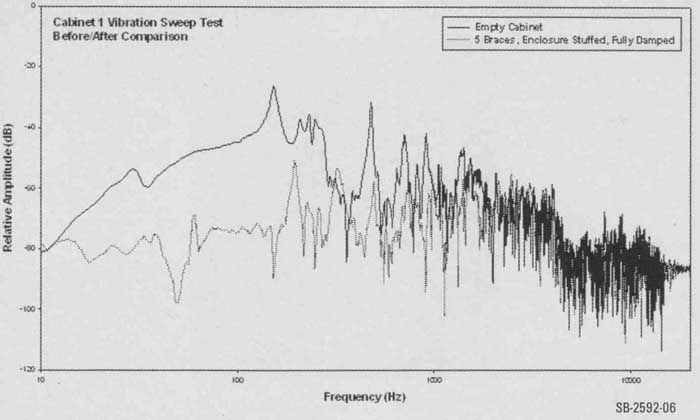
FIGURE 6: Before/after sweep results.

FIGURE 7: Before / after impulse.
Figure 7 is the “before” and “after” vibrational response to impulse stimulation. In this particular graph, “before” is the response plotted on the right, the “after” plotted on the left. The improvement in settling is striking.
Thus far, you’ve seen what the accelerometer has had to say. To see what the microphone had to say, I employed the noble knuckle-rap test. I removed the accelerometer, rapped away at the spot formerly occupied by it, with microphone positioned nearby. In Fig. 8, the “before” curve (top) presents a generally higher relative amplitude response than the “after” curve (bottom). The difference, however, sounded much greater than it appears here.
Figures 9 and 10 are the time-domain versions of the data presented in Fig. 8.
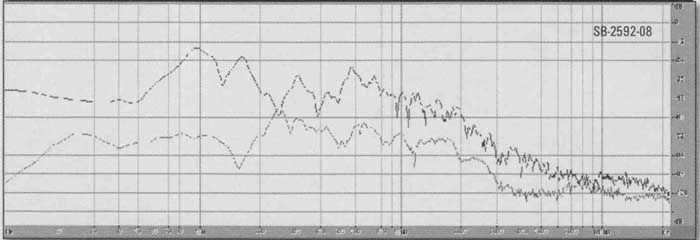
FIGURE 8: Spectral analysis, before /after knuckle rap test.

FIGURE 9: “Before” knuckle rap test.

FIGURE 10: “After” knuckle rap test.
CLOSING COMMENTS
Measurement indicated that the various readings taken to reduce panel vibration were effective in lowering the mechanical noise floor of the system. However, objective assessment tells only part of the story, and subjective assessment is required to complete a picture of any system’s performance. Photo 5 shows the test system.
Though the cabinets are attractive in their unfinished state, with an appearance reminiscent of, for example, some of Axiom’s current line of products, they will eventually have a finish applied. The choice of finish, though, is left to my wife—an effective approach for increasing WAF or SAF.
= = = =
ABOUT THE KEF B139 DRIVERS
I first became acquainted with KEF B 139 drivers back in the late 1970s. In those days I was working in a recording studio ‘programming” a Moog synthesizer (“Programming” back then meant plugging the Moog’s patch panels full of patch cords.) I remember carrying around a three-ring binder full of preferred patches. Ancient history!
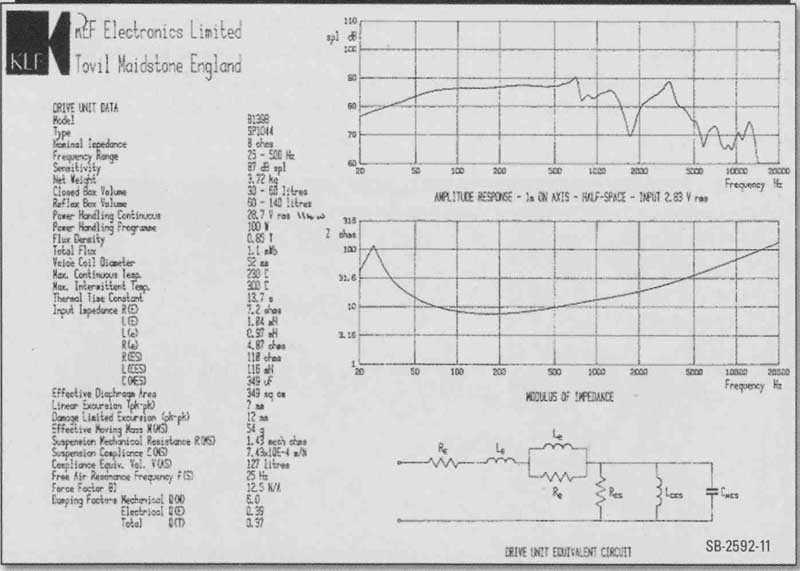
FIGURE 11: B139 spec sheet, ca 1980s.
The synthesizer fed its output, via a Dynaco power amp, into a pair of IMF transmission-line loudspeakers that used the B-139 as the woofer. The bass those things could crank! My teenage ears were impressed.
Outside of live music situations, I had never heard such low bass at such volumes. (Remember, we’re talking late ‘70s here; monster subs were not as commonly available as they are today.) Years later I would see B139s used in Wilson Audio’s $ 100k + US WAMM loudspeaker system.
Over the years I acquired half a dozen of the units for my driver collection. I used them mainly for re search purposes. Because they had just been lying around gathering dust, when it came time to design a general-use system for the house, it was a no-brainer to design the mid- bass modules for the system around them.
Though technology has certainly provided for many substantial advances in driver quality since the B139s were first introduced over 30 years ago, there are some things they do well to this day.
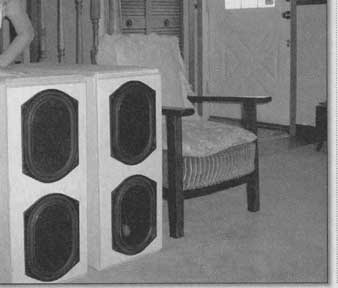
= = = =
I conducted two listening tests, each lasting about an hour, using a variety of material with which I and four other listeners were very familiar. The up stream test gear used in both instances was the same (Hafler DH-500 power amp, and so on).
At the conclusion of both tests, results were tabulated. From the raw data collected, I threw out everything people thought they heard. Due to the very informal, unscientific nature of the test trials, I was interested only in certainties. I also discarded data for which no consensus could be reached. In the end a few things did emerge.
First, resolution of low-level detail was dramatically improved. This was not some at-the-fringe, barely discernible effect; it was a substantial improvement. On this point, all listeners were unanimous. I heard things in recordings I have listened to for decades that I had not heard before.
Second, overall mid-bass clarity improved, resulting in, among other things, improved sound staging. Individual instruments, such as cellos in classical recordings were now discernible as individual instruments, where before they tended to sound more like massed string choruses, made up of not clearly identifiable individuals. The tonal differences between different pianos, such as Steinway, Yamaha, Blüthner, and so on, was now clearly discernible.
It appeared that the “before” mechanical noise floor had imparted a euphonic sameness to everything played through the system. Now that “sameness” had been largely, though not entirely, eliminated. Overall, the system’s presentation had become more realistic and musical, resulting in a more satisfying listening experience. Not bad when you consider how old a technology the KEF B139 drivers represent.
RESOURCES
1. Beranek, Leo L., ed., Noise and Vibration Control, McGraw-Hill, mc, New York 1971.
2. Mclntire, M. E., et al., “The Influence of Geometry on Linear Damping,” Acustica, Vol 30, #4, 1978.
3. Caldersmith, Graham, “Vibration Theory and Wood Properties,” Journal of the Cat gut Acoustical Society, #42, November 1984.
4. No author listed, “Measuring Vibration,” Brüel & Kjaer Naerum, Denmark, September 1982.
5. Eren, Halit, “Acceleration, Vibration S Shock Measurement,” The Measurement Instrumentation and Sensors Handbook, CRC Press, 1999.
6. Brown, Alastair, W. M., The Ensemble Statistics of the Response of Structural Components with Uncertain Properties, Doctoral Dissertation, University of Cambridge March 2003.
7. No author listed, “Piezo Film Sensor Technical Manual, Part ii of 18,” Measurement Specialties Valley Forge, PA, 1998.
8. Renninger, Jennifer: Understanding Damping Techniques for Noise and Vibration Control, E-A-R Specialty Composites. Indianapolis, Ind., 2000.
9. Green, David W., et al, “Mechanics Properties of Wood,” Ch. 4, Forest Product Laboratory Wood Handbook, Madison, MT. 1999.
10. Harwood, H. D., et al, "Factors in the design of loudspeaker cabinets," BBC RD 1977/3, January 1977.
11. Iverson, J. K., "The Theory of Loud speaker Cabinet Resonances," Journal of the Audio Engineering Society, Vol. 21, #3, April : 1973.
12. Tappen, P. W., "Loudspeaker Enclosure Walls," Journal of the Audio Engineering Society, Vol. 10, #3, July 1962.
13. Caldersmith, G. W.: "Vibrations of Orthotropic Rectangular Plates," Acustica, Vol. 56, 1984.
14. Mclntire, M. E., et al., "On Measuring Wood Properties, Part I," Journal of the Cat gut Acoustical Society, #42, November 1984.
15. Anocast Polymer Structures, Anorad Corporation, New York 2002.
16. Bauer, B.B., "Equivalent Circuit Analysis of Mechano-Acoustic Structures," Journal of the Audio Engineering Society, Vol. 24, #8, October 1976.
17. Blind, Henry Dorfstatter, Walter; and Geddes, Earl; "In Pursuit of Elusive Loud speaker Parameters," Journal of the Audio Engineering Society, Preprint, 2234 (E-2), 1985.
18. Bradbury, L.J.S., "The Use of Fibrous Materials in Loudspeaker Enclosures," Journal of the Audio Engineering Society, Vol. 24, #3, April 1976.
19. Bodig, Jozsef and Joyne, Benjamin A., Mechanics of Wood and Wood Composites, Van Nostrand Rheinhold Company, New York, 1982.
20. C., Martin, High Performance Loudspeakers, John Wiley & Sons, New York 1978.
21. Den Hartog, J. P., Mechanical Vibrations, McGraw-Hill Book Company, Inc., New York, 1947.
22. Fahy, F. J., "A Simple Method For Measuring Loudspeaker Cabinet Impedance," Journal of the Audio Engineering Society, Vol. 41, #3, March 1993.
23. Feit, David, "Pressure Radiated by a Point-Excited Elastic Plate," Journal of the Acoustical Society of America, 1966.
24. Gere, James M., and Timoshenko, Stephen P., Mechanics of Materials, PWS Publishing Company, Boston, MA, 1997.
25. Harcourt, R. I., "An acoustically small loudspeaker," Wireless World, October 1980.
26. Ih, Jeong-Guon., "Acoustic Wave Action Inside Rectangular Loudspeaker Cabinets," Journal of the Audio Engineering Society, Vol. 39, #12, December 1991.
27. Iverson, James K., "The Theory of Loudspeaker Cabinet Resonances," Journal of the Audio Engineering Society, Vol. 21, #3, April 1973.
28. Jensen, Alfred and Chenoweth, Harry H., Applied Strength of Materials, McGraw Hill Book Company, mc, New York, 1975.
29. Karjalainen, M., et al., "Comparison of Numerical Simulation Models and Measured Low-Frequency Behavior of Loudspeaker En closures," Journal of the Audio Engineering Society, Vol. 49, #12, December 2001.
30. Leach, Marshall W., "Electroacoustic Analogous Circuit Models for Filled Enclosures," Journal of the Audio Engineering Society, Vol. 37, #7/8, July/Aug. 1989.
31. Leissa, Arthur, Vibration of Plates, Acoustical Society of America, American Institute of Physics, 1993.
32. Moriyasu, Jim, "Panel Damping Studies: Reducing Loudspeaker Enclosure Vibrations," audioXpress , February 2002.
33. Morse, Philip M., Vibration and Sound, McGraw-Hill Book Company, Inc., New York, 1936.
34. Murphy, David J., "Axisymmetric Model Of A Moving-Coil Loudspeaker," Journal of the Audio Engineering Society, Vol. 41, #9, September 1993.
35. Sanfilipo, Mark, "Inductor Coil Cross talk," Speaker Builder, October 1994.
36. Small, Richard H., "Closed-Box Loud speaker Systems Part 1: Analysis" Journal of the Audio Engineering Society, Vol. 20, #10, Dec. 1972.
37. Small, Richard H., "Simplified Loud speaker Measurements at Low Frequencies," Journal of the Audio Engineering Society, Vol. 20, #1, Jan/Feb. 1972.
38. Steidel, Robert F., An Introduction to Mechanical Vibrations, John Wiley & Sons, mc, New York, 1971.
39. Strahm, Chris M., "Complete Analysis Of Single And Multiple Loudspeaker Enclosures," Journal of the Audio Engineering Society, Preprint, 2419 (D-1), 1986.
40. Tappan, Peter W., "Loudspeaker Enclosure Walls," Journal of the Audio Engineering Society, Vol. 10, #3, July 1962.
41. Young, Dana, Vibration of Rectangular Plates by the Ritz Method, American Society of Mechanical Engineers, Vol. 17, 1950.
============
